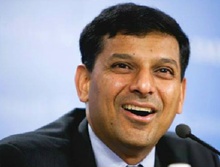RBI keeps rates unchanged; says banks have enough leeway now
01 Dec 2015
 The Reserve Bank of India (RBI) left all policy rates unchanged at its fifth bi-monthly monetary policy review today, amidst lingering inflationary pressures, after having cut the repo rate by a sharp 50 basis points at its previous meeting.
The Reserve Bank of India (RBI) left all policy rates unchanged at its fifth bi-monthly monetary policy review today, amidst lingering inflationary pressures, after having cut the repo rate by a sharp 50 basis points at its previous meeting.
Accordingly, the policy repo rate under the liquidity adjustment facility (LAF) remains unchanged at 6.75 per cent. RBI said it will continue with its daily variable rate repos and reverse repos to smooth liquidity.
The cash reserve ratio (CRR) of scheduled banks will also remain unchanged at 4.0 per cent of net demand and time liability (NDTL).
Consequently, the reverse repo rate under the LAF will remain unchanged at 5.75 per cent, and the marginal standing facility (MSF) rate and the Bank Rate at 7.75 per cent.
RBI said it will continue to provide liquidity under overnight repos at 0.25 per cent of bankwise NDTL at the liquidity adjustment facility (LAF) repo and liquidity under 14-day term repos as well as longer term repos of up to 0.75 per cent of NDTL of the banking system through auctions.
RBI said it has made a 125 bps reduction in the repo rates since January, but less than half of the cumulative policy repo rate reduction has been transmitted by banks. The median base lending rate has declined only by 60 bps. The RBI said it will shortly finalise the methodology for determining the base rate based on the marginal cost of funds, which all banks will move to.
RBI cited provisional estimates of gross value added (GVA) at basic prices for Q2 of 2015-16, which rose on the back of acceleration in industrial activity, to suggest that the economy is in the early stages of a recovery, though with some areas of continued weakness.
Value added in agriculture and allied activities picked up on the modest increase in kharif output and timely policy interventions to stem the effects of the deficient south-west monsoon.
Overall, RBI said, the current outlook for agricultural growth in 2015-16 appears moderate as the adverse effects of a slow north-east monsoon has been partly offset by the subsequent cyclonic weather that improved precipitation and raised the probability of a normal monsoon.
The index of industrial production picked up in the second quarter. Early results of the Reserve Bank's order books, inventories and capacity utilisation survey indicate that there was robust growth in new manufacturing orders in the second quarter, and finished goods inventories declined while raw materials inventories increased.
However, while urban consumption is showing signs of a pick-up in some areas such as passenger vehicles sales, rural demand has been weakened by two consecutive deficient monsoons and slowing construction activity.
Nevertheless, RBI said, new project announcements as measured by the Centre for Monitoring Indian Economy grew more strongly in the second quarter. It remains to be seen whether growing public investment can crowd in private investment on a sustained basis, despite the still-low capacity utilisation, it added.






















